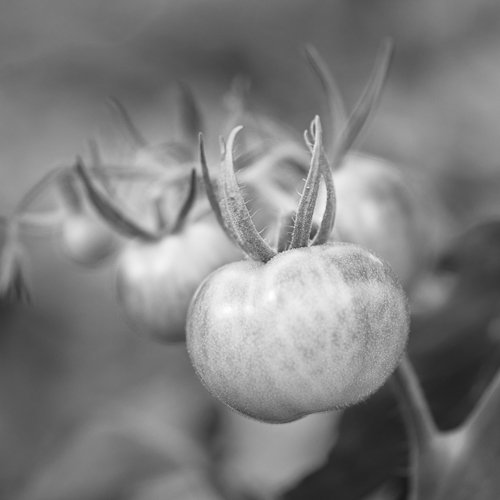Since the Vargiu family are both agriculturalists and pastoralists, we also visited their farm consisting of two greenhouses with a combined area of 2.5 hectares where they are growing tomatoes along the alluvial plain of Santa Margherita di Pula.
Upon our arrival, we were met by Efisio Vargiu’s wife, Maria Teresa, who showed us the way to the greenhouses where Cristiana and Tiziana Vargiu were tending tomato plants. Their brother Giuseppe was apparently working with artificial irrigation, dividing his time with shepherding goats in the highlands in the morning and doing whatever is required in the greenhouses in the lowlands in the afternoon.
Both Cristiana and Tiziana were originally students, but broke off their studies in order to grow tomatoes. Both of them being aged about 30, said their choice was deliberate, but also difficult.
Walking between the lines of tomatoes, we notice the difference between inside and outside. We are approaching November, but the air is dry and the temperature is about 28°C, while it’s constantly 26°C and somewhat humid inside, parameters which are necessary for cultivating tomatoes. The type of tomato they are cultivating remains firm and fresh even after maturation, making them very popular in the market.
Regarding cultivation, the tomato plants are planted in the beginning of September. First, a straight furrow is made in the soil, then a hose with small. regularly spaced holes is extended along the whole furrow. Finally, the small tomato plants, having a height of about 10 cm, are planted next to each hole in the hose such that they can be watered with droplets, which is called drip irrigation. More information on drip irrigation can be found here.
As the mother plant is growing, shoots will inevitably start appearing and Tiziana and Cristiana have to decide if they shall let the plant have two or three shoots. They have chosen to have three, while some other growers prefer two. Tomato plants are climbers/vines and the shoots grow quickly upwards. In order to prevent that they fall down, thin twines are attached to each shoot and also to a horizontal metal bar about 2 m above each row of tomato plants. Then, the twine is twisted around the plant, a procedure which has to be repeated as the shoot is growing upwards. Another operation, which has to be done continuously, is to remove leaves since new shoots will often appear and start growing leaves. Often, two shoots start growing in opposite directions at the same level. Only one of the shoot is wanted because the leaves require nutrients, while the cultivators want them to arrive at the tomatoes as far as as possible. At the same time as Tiziana and Cristiana are removing leaves, they are also monitoring the health of the plants. A common disease is tomato leaf mould, whose first symptom is white spots on the leaves.
When the tomato plants are approaching the metal bars suspended over each row of tomato plants, they have to be lowered, else they will go on growing and degrade the quality of the tomatoes. If the tomato plants are supported by twine, this entails a lot of work for each plant as Giuseppe showed us. Alternatively, they are also using some kind of suspender, which makes this operation very easy. We were told that the tomato plants have an ideal height where they produce tomatoes at seven different levels. Having attained an ideal height, the Vargiu siblings may harvest tomatoes at the lowest level three months after the tiny tomato plants were planted. As time passes, they can harvest tomatoes from the second lowermost level and so on. Harvest lasts from December to June when the tomatoes at the highest level are harvested.
After having been harvested, the tomatoes are sorted in a machine according to their sizes. Then, they are packaged and sold wholesale to retailers.The room with the tomato sorting machine also contain some apparatuses for receiving goat’s milk brought by Giuseppe and his father back to the farm.
In order to pollinate the tomato plants, small boxes with cultured bumblebees are placed inside the greenhouses. Pollen on the male tomato flowers is released by means of buzz pollination. An introduction to pollination can also be found here.
Although using drip irrigation limits waste of water, not all of it will be consumed by the tomato plants, leading to that weeds will start growing where the soil is humid. Since they also need nutrients from the soil, weeding has to be done occasionally.
In July and August, old plants are uprooted, the soil is plowed, manure is added and new furrows are made. Then, another set of small tomato plants are planted and drip irrigation is set up again, repeating the growth cycle.

